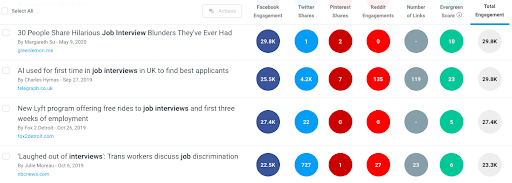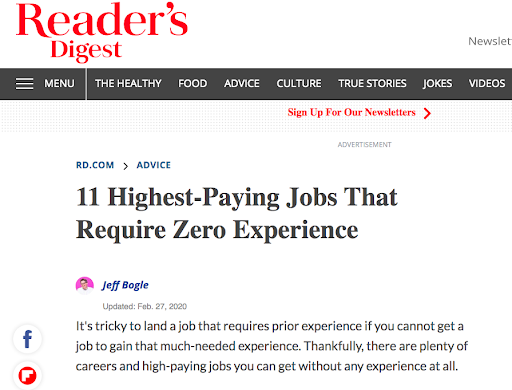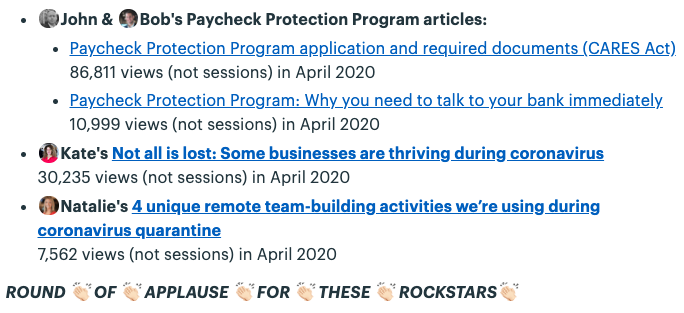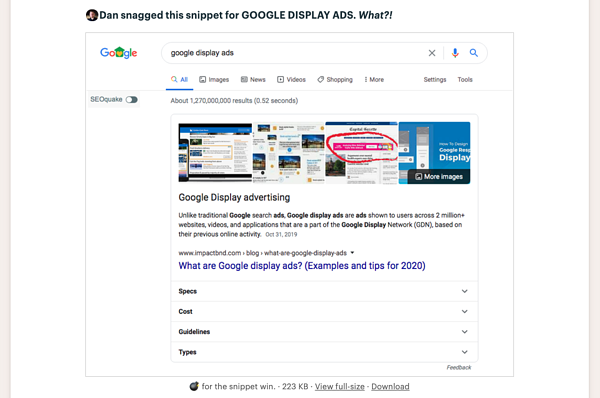Marketing Strategies
Now Is The Time To Find And Correct Your Digital Strategy Pitfalls
/
/Every brand or enterprise is crafting and refining their digital strategy on a daily basis. However, especially in the world of B2B, companies fall into many of the same mistakes.
According to a 2019 Forrester report, “44% of B2B buyers expect to do more than half of their work-related purchasing online in the next three years.” In the wake of COVID-19, that figure is probably even higher. It is crucial that marketers create engaging digital content, leveraging every digital touchpoint as an opportunity to build trust and strengthen relationships.
Marketers have access to more target audience research and data than ever before, but that doesn’t mean it is easy to avoid pitfalls. Let’s consider the consequential B2B marketing mistakes that companies are making, and demonstrate why a digital strategy audit is the solution.
Your Content Shouldn’t Reflect Your Organization Chart
Too often, companies — particularly B2B enterprises — build their websites and digital assets around their internal organization structure rather than a customer’s needs. As an example, imagine you are a customer looking for a mop. You surf to a company’s website to buy a complete cleaning solution, but they have separate pages for mop handles and mop heads because they operate as separate divisions. Now you have to research the parts separately, figure out what you need and ensure they are compatible with one another. That’s not a huge ask for a mop, but imagine you are purchasing a complicated business system with hardware, software and a consultative service component.
Your Messaging Should Focus On The Customer, Not The Product
Companies often lead with the news of the capability or product they just launched, but prospects don’t come to your website for product announcements. They visit because they have a question or a problem. Your messaging should show people you understand that problem. This is a best practice for all marketers, but it is especially true for those marketing to developers, engineers and the C-suite. These audiences are highly skeptical of “marketing speak” and an overly product-forward content strategy will turn them off. Plus, leading with product makes your company seem uninterested in building strong audience bonds.
Don’t Overload One Area Of The Buyer Journey With Content But Neglect Others
Another mistake that is easy to overlook when you are inside the organization is creating content around some areas of the buyer journey, but not others. If your organization doesn’t have a healthy mix of content formats, you may be making this error. For example, you might have multiple white papers and blog articles that are relevant to a prospect comparing competitive solutions, but no video to share on social media to create brand awareness.
It is also common to create content for one audience segment but forget about other personas, or simply run out of time and resources. B2B purchasing decisions involve multiple decision-makers with different priorities and needs. A complete digital strategy needs to encompass all of them, which is part of what makes B2B marketing so challenging.
Don’t Overuse Jargon
Your existing customers know your lingo, but new ones may not. It is important that your messaging and content use natural language, rather than jargon, so it resonates with your audience. This may sound like a simple one, but it can be hard to catch yourself because you are accustomed to the company’s lexicon.
Why Now Is The Time For A Digital Assessment
The first step in fixing mistakes is finding them. Your company may have slowed or even stopped marketing initiatives in response to COVID-19, so use this time to audit your digital strategy.
There isn’t an industry on the planet that hasn’t been upended by the pandemic. Buying processes have changed overnight, so even if your company has managed to avoid these marketing traps, you still need to audit your strategy and update it to reflect the new normal.
A comprehensive review should include:
- A content audit and effectiveness assessment;
- A website CX health assessment;
- A channel audit and effectiveness assessment;
- A brand message assessment; and
- An event strategy assessment.
The good news is an audit will likely uncover low-hanging fruit — low-effort/high-impact actions you can take to drive fast results for your company. Next, you can devise a plan for tackling the bigger initiatives.
Remember, as a B2B marketer, your goal is to build relationships with prospects and to lead them through their consideration journey, fostering trust every step of the way. The missteps above compromise your ability to do so. An audit kicks off the process of doing this right.
Greg Harbinson is the Senior Strategy Director at Centerline Digital, where he focuses his time on helping companies create messaging and experiences to better communicate with their customers. His work includes building messaging frameworks, defining the information architecture for websites, designing customer experience programs and helping companies understand the best ways to solve communication problems.
Marketing Strategies
Instant messaging has taken over the world, but this is just the beginning
30-second summary:
- Chatbots will soon be ubiquitous in written business communication, and they present a paradox that flips everything consumers think they know about automation on its head.
- Customer input to a company is valuable information, and using messaging apps, customer feedback can also become actionable. By interacting with a bot, a customer is leaving an eternal record of their input, whatever it is, in a system that can read, analyze, and internalize the information.
- Furthermore, instant messaging apps and VoIP present the possibility of integrating video or phone calls into your communication. The combination of fluid written conversation and video has opened the door to digital transmission in many fields traditionally reserved for face-to-face interactions.
- Instant messaging has a fluidity that resembles that of spoken conversation. This fluidity is coming to good use now, especially for small businesses, which operate by one-on-one interactions, for which investments in big and bulky IT-systems are beyond superfluous.
The conversation surrounding the digitization of society has sounded in classrooms, newsrooms, and marketing departments for decades. During the pandemic, the process was accelerated as instant messaging came to the rescue, earning much-justified praise for helping people maintain connections even at a distance.
If there is one thing the process has taught us, it’s that the future has a way of sneaking up on us. So what will messaging look like, before we even know it?
The value of chatbots
Chatbots will soon be ubiquitous in written business communication, and they present a paradox that flips everything consumers think they know about automation on its head.
Generally, many people think the bots reflect over-automation and less-personalized service. Yet regular, human employees at corporations usually have very standardized, canned responses as well, offering only a veneer of personal service.
Chatbots reveal that the truly important part of the communication between a business and its customers is what the customers have to say, and bots’ role will become increasingly important.
Customer input to a company is valuable information, and using messaging apps, customer feedback can also become actionable. By interacting with a bot, a customer is leaving an eternal record of their input, whatever it is, in a system that can read, analyze, and internalize the information.
Instant messaging apps and VoIP provide an added layer of personalization
Furthermore, instant messaging apps and VoIP present the possibility of integrating video or phone calls into your communication. The combination of fluid written conversation and video has opened the door to digital transmission in many fields traditionally reserved for face-to-face interactions.
Tele-health, yoga-classes, and education are but a few examples of services ready to adapt, and they quickly managed to deploy instant messaging.
Experiences resembling one-on-one interactions, but still taking place at a distance, are essential and more useful than ever before. This will remain true well after COVID, as businesses and individuals alike become accustomed to the efficiency and effectiveness of such interactions.
Until now, messaging has mostly involved replicating real-world communication in the virtual world as seamlessly as possible.
But what if virtual communication were actually an improvement of physical communication? Imagine having a live call with someone across the globe who speaks a different language.
In real-time, the software can recognize the speech, anachronistically translate it, intelligently adjust for tone, prevent misunderstanding, or warn you that you might be stumbling into a cross-cultural faux pas.
The software could be intelligent and integrate with your calendar. As soon as you agree to meet someone for dinner, automatically, a reservation is made at your favorite restaurant and the event is added to your calendars.
This technology will be made available sooner than we think, and messaging apps will be the ones to implement them.
Instant messaging to play a major role in the evolution of communication
Messaging services will become the bridge between impersonal email and human touch. There is a reason messaging apps consume the most significant part of people’s internet use.
Whether consumers use social media platforms, dating apps, or office communication systems, it’s the messaging that gets people hooked.
Instant messaging has a fluidity that resembles that of spoken conversation. This fluidity is coming to good use now, especially for small businesses, which operate by one-on-one interactions, for which investments in big and bulky IT-systems are beyond superfluous.
Though it might not seem like it, society is still new to digital communications. The technology is in its infancy, and companies and individuals alike are still figuring out how to harness it in the best way.
By expanding its functionality and integrating instant messenger services to more facets of society, we improve the quality of the conversation between people, businesses, and institutions—one more step along the path to enhancing society with digital technologies.
Djamel Agaoua is the CEO of Rakuten Viber, one of the world’s largest mobile applications with 800+ million users worldwide, offering a range of features such as one-on-one chats, video calls, group messaging, social shopping, and updates. A veteran executive with a track record of growing innovative global techs, Djamel is a private investor and sought-after board member, advisor, and speaker.
The post Instant messaging has taken over the world, but this is just the beginning appeared first on ClickZ.
Marketing Strategies
Want media coverage? Make sure your content is emotional
30-second summary:
- Emotion is a pivotal component of great content.
- If you have an opportunity to create emotional content, you’re much more likely to be successful.
- A new Fractl study reveals what emotions are most common in highly-linked-to content in each industry.
- You should explore what emotions are already prevalent in your industry to gain new ideas and understand what already resonates with your audience.
- When pitching content to writers, highlight the key emotional takeaways so reporters glean them quickly.
Yes, content should be useful. In fact, nine times out of 10, it must be useful in order to make an impact. But emotion is pivotal too. Emotion can form a sense of connection between a reader and a story — between a reader and their place in the world. For this reason, emotion can sometimes carry an entire piece of content because it taps into our common humanity. How do you hit the right chords with emotional content? Here are tips on how to do that.
Sure, it sounds corny. But that doesn’t make it any less true. Emotion matters, and if you have an opportunity to create emotional content, you’re much more likely to be successful.
1. Understand which emotions resonate in your industry
Before jumping into content creation, it’s good to understand what works well in your particular niche. What content that’s been created has performed well, and why? What emotions are present in some of the most talked-about content?
In a recent Fractl study, we looked at more than 5,000 pieces of content that earned at least 25 backlinks. Then we explored which Facebook reactions were more prevalent in each content niche.
This breakdown provides a great overlook of what emotions are already prominent in your niche’s content. Look at how anger appears in sex/relationship stories while love appears often in travel stories.
Why do you think these emotions may be associated with your niche? What can you cover that hasn’t already been covered that taps into why people are upset or in awe?
To gain more industry insight, before creating content, I would:
- Pull out my customer personas. What emotions are tied to what they worry about? Struggle with? Seek out? Can I apply these emotions to content?
- Read my target publications’ content. Which articles are on the front page? Which got the most engagement? What emotions are featured in them?
- Check BuzzSumo to see what content is most engaged within my industry. Not only will this highlight certain emotions that are prevalent, but it’ll also let you know if an idea you have has already been covered in depth.
Take a look at some of the highly-engaged-with stories that appear on the BuzzSumo content search for “job interview”.

Just from this snapshot of stories, you can see multiple emotions: humor/laughter regarding funny anecdotes, fear that the job application process might be totally changed by AI, happiness at the kind gesture from Lyft, and contempt at discrimination taking place at interviews.
Perhaps honing in on one of these emotions can spark an idea. What else might people be afraid of regarding the job application process? What else are they angry about? Happy about?
When all else fails, capitalize on the feeling of surprise. Our research on viral emotions revealed that the most common emotion in viral images is “surprise”. People like to learn something new that’s unexpected. If your data reveals data points like this, make sure to highlight it in the project.
2. Identify which emotions to focus on in your content
When trying to come up with content ideas, ask yourself: What emotions are tied to this concept? What are the different circumstances people can encounter, and how do those circumstances make them feel?
For example, for our client The Interview Guys (a job interview advice portal), we considered the variety of issues that can come up related to work. One such idea that hadn’t been fully addressed, in our opinion, was burnout.
Burnout in and of itself is an emotional topic. It’s associated with stress, anxiety, and exhaustion. After surveying people about burnout, we earned coverage on Inc., Yahoo Finance AU, and International Business Times.

But not every idea will be as emotionally straightforward. Perhaps you have an instinct that analyzing a certain data set would yield interesting results.
Push yourself to identify
What would make those results compelling? What insights might this data help us gain, and what emotions are involved with these insights?
For example, in a separate project for the same client, we thought about identifying jobs that pay well that don’t require years of education. What we’d end up with is a list of jobs and what they’d pay.
On the surface, this may not seem too emotional. But let’s consider the layers involved here:
- Less schooling means less stress, less debt, and less pressure.
- The potential to make a good salary provides hope.
- Struggling to find a job with little to no experience can give someone a lot of financial and emotional anxiety.
- Why would people care about this information in the first place? They’re looking to switch jobs. For whatever reason, they’re dissatisfied.
So you have stress, anxiety, hope, and dissatisfaction as some examples of emotions tied into this list of jobs. It’s not just a list anymore, is it?
Call upon these feelings every time you make a decision about the project. It’ll help keep you focused on the real soul of the story.
3. Pitch the emotional angles
When you can identify these emotional elements, you’ll also know how to better promote the idea.
We pitched the high-paying-jobs project to publications. Take a look at some of the coverage.

Source: Reader’s Digest
Reader’s Digest opens with the dilemma of not being able to find a job because you don’t have enough job experience yet. They’re tapping into a common, shared frustration people have, and by starting the article this way, they’re immediately putting the reader in a frame of mind to connect emotionally with the content.

Source: MarketWatch
This headline taps into the hope angle; they’re essentially saying, you don’t have to be the typical tech person to make a lot of money with little experience.
When you pitch writers, make sure to include the emotional data points and angles prominently. Include bullets of the most impactful takeaways so the reporter doesn’t have to dig through the data to understand why it matters and why their audience will care.
And don’t do the same thing for every publisher. Consider their particular audiences and what they care about, and then tailor your data points to speak to those readers.
Conclusion
Data is only as powerful as the story it tells, and all of the best human stories are packed with emotion. In every stage of your content creation process, from ideation to design to promotion, keep the emotional components in mind and center them.
Amanda Milligan is the Marketing Director at Fractl, a prominent growth marketing agency that’s worked with Fortune 500 companies and boutique businesses.
The post Want media coverage? Make sure your content is emotional appeared first on Search Engine Watch.
Marketing Strategies
How to create a monthly content marketing ROI newsletter (+ examples)
Day in and day out, you’re busting your little booty, to get revenue-generating content produced and published. As the days, weeks, and months roll by, you see the numbers tick up. You see the search ranking wins. You see how content is being used throughout the sales process to close deals.
You see that the right content can and does drive more traffic, leads, and sales for your company. That’s a great feeling, isn’t it? To know the work you’re overseeing is driving actual results for your company.
🔎 Related: How to track and report the ROI of your content marketing
Yet you struggle to get your teams excited about your content efforts. They say see the “value” of it, in theory, but they still run from deadlines… if they’re even willing to create content for you to begin with.
Bottom line, no matter what you do, content is your #1 priority, but somehow always dead last for everyone else. What’s the real problem here? And how do you fix this?
You know what the content ROI wins are, but does the rest of your company?
Marcus Sheridan once said in a meeting that folks almost always say they “don’t have time” for something they don’t truly see the value in. Because, if something is truly valuable or beneficial (in their eyes), they will make the time for those activities.
That really stuck with me, because he’s absolutely right.
Moreover, this is particularly true when it comes to rallying your troops around the battle cry of creating content as a means to move the needle for your company. So, ask yourself this:
You know content is driving the wins your company needs… but what about everyone else? If the answer is, “Crap, no. No, they don’t,” don’t worry. You’re in the right place. This is precisely what we’re going to fix together in this very article.
You see, we’ve talked extensively in the past about how to measure the ROI of your content marketing efforts, but I want to dig a little more deeply into one specific tactic I’ve found that seems to have a more profound impact on the excitement levels around content creation:
An internal bold, in-your-face, visual, numbers-focused content wins newsletter.
Prerequisites and considerations for your company’s content wins newsletter
Before I show you what goes into such a content wins newsletter — a newsletter I publish internally for IMPACT, so I know for a fact that it works — there are a few housekeeping items we need to review first.
First, you must have the right marketing and sales technology in place that connects the dots and shows what closed deal contacts are looking at on your website. At IMPACT, we have both the HubSpot Marketing and Sales Hub products. Because our marketing automation and our CRM are under the same digital roof, every deal closed also shows all of the marketing automation data (pages viewed, forms filled, subscriptions, and so on).
🔎 Free IMPACT+ course: Fundamentals of ROI reporting in HubSpot
You need to have this kind of deep level of ROI reporting in HubSpot (or other platform). Otherwise you can’t do what I’m about to show you.
Second, you need to dedicate as much time to data analysis, Google search ranking review, and reporting as you do to the movement and publication of your content strategy. I mean, you shouldn’t just be doing this for the creation of this newsletter; you should be doing this all the time. How will you know your content is working, right?
For instance, I have a set time each week that I go cliff-diving into all of the numbers. But, since I’m a lunatic, I do some form of this task every day.
Finally, you need to determine how you will distribute your “content wins newsletter.” I know the term “newsletter” immediately makes you think of email, but not so fast! While you certainly may want to go the email route, there are other options.
For example, at IMPACT, we use Basecamp for project management, as well as team- and company-wise communications. So, for our content wins newsletter, I opted to use the message board function for two key reasons:
- I already struggle to get people to read emails to begin with. Why would I tempt fate by creating another email?
- I often run into staging, formatting, and imagery limitations with email. And I like my content wins newsletter to look fun and visual.
On top of that, as a Basecamp message board publication, I create a single spot for people to virtually celebrate, react, and post encouraging messages:
With an email, you don’t get this kind of out-in-the-open celebration and excitement on display. Yes, you might get a few replies, but it doesn’t have the same effect. Additionally, a platform like Basecamp allows me to tag folks, so people are notified their work, specifically, has been featured in the content wins newsletter.
What should a content wins newsletter include?
Before we dive in, one quick thing. I am going to show you examples of what we include in our content wins newsletter, but I will be doing so in bits and pieces. Why? Well, understandably, it contains a lot of private internal data.
Every month, the story of our content wins evolves and changes. So, I may weight certain wins more heavily than others. That being said, every month, I recommend an overview of the following.
1. An explanation of what the newsletter is
Pretty simple, right? Remind everyone first what the newsletter is all about:

Do this even if they know it’s coming. Even if they’ve seen it before, put some sort of reminder at the top of what the newsletter is all about. And, if it’s your first one (like mine above), celebrate the fact that it’s the first one and get people pumped about it! Set expectations around what it is and how often they will receive it.
2. Traffic growth or changes
If your traffic is growing, awesome! Celebrate it and then explain why. Are you experiencing organic growth? Did you have a couple of all-star email campaigns? Were there a few high-performing pieces of content that picked up the pace for you? All (or some) of the above? Share that with the team!

Keep in mind, however, that not everyone speaks your language. So, when necessary, provide context and education:

Remember, not everyone is a content marketer.
3. Short- and long-term traffic champs 🏆
I like to not only feature the most recent month ended, but also the previous three months as well. That’s because we often don’t see organic traffic growth really take root until after the first 30 days a piece is published.

“Wait, what are all those ‘non-coronavirus’ notes you have?”
Great question! In the month of April, I measured and tracked our extensive coronavirus-related insights and articles separately, since they were developed outside of our core strategy, to meet an in-the-moment need for our audience. I also didn’t want their performance to eclipse the other gains we made.
4. Featured snippet and search ranking wins
This one is pretty self-explanatory. I show-off somewhere between five and 10 featured snippet and search ranking wins:

In addition to a screenshot of the snippet or rank, I’ll tag the person and use lots of awesome, celebratory language.
5. Finally, a closed deal spotlight
Look, traffic and search ranking wins are all great and should be publicly applauded. But if your content isn’t bringing home the revenue bacon, then what exactly are you doing with your content strategy, right?
With that in mind, I like to close the newsletter with a closed deal spotlight that showcases the exact content a contact consumed before the signed a deal with IMPACT:

In it, I give credit to the sales rockstar who closed the deal, how much revenue was brought in-house from that deal, how many pages of content were consumed in total, and then the exact pieces of content they reviewed before the deal was signed.
This is probably the most effective and powerful way to showcase how your content is not only helping you bring in traffic and leads, but also actually helping your company make money.
Your genuine excitement (or lack thereof) will make your break your content wins newsletter
Before you go off on your quest to write your very first content marketing ROI newsletter, I need you to understand one thing.
I used a lot of emojis, exclamation points, nicknames, and other excitement-rooted elements in the messaging, formatting, and positioning of our content wins newsletter, and this is by design.
🔎 Free IMPACT+ course: How to build a content strategy in the digital age
If you don’t demonstrate excitement for the wins, your people will not get excited either. Moreover, if you don’t demonstrate a genuine thrill in seeing your coworkers’ hard work pay off in traffic, leads, and sales, you won’t create any warm and fuzzy feelings within them.
You don’t need to copy my voice and tone exactly, as shown above, but you need to find your own way to show sincere enthusiasm for your wins and joy in the success of others.
Your numbers alone won’t shift the culture of content within your company. How you position those wins are critical to the success of your newsletter and the overall increase in positive sentiment your coworkers feel about content.
-
 Business3 weeks ago
Business3 weeks agoBernice King, Ava DuVernay reflect on the legacy of John Lewis
-
World News2 weeks ago
Heavy rain threatens flood-weary Japan, Korean Peninsula
-
 Technology2 weeks ago
Technology2 weeks agoEverything New On Netflix This Weekend: July 25, 2020
-
Finance3 months ago
Will Equal Weighted Index Funds Outperform Their Benchmark Indexes?
-
Marketing Strategies7 months ago
Top 20 Workers’ Compensation Law Blogs & Websites To Follow in 2020
-
 World News7 months ago
World News7 months agoThe West Blames the Wuhan Coronavirus on China’s Love of Eating Wild Animals. The Truth Is More Complex
-
Economy9 months ago
Newsletter: Jobs, Consumers and Wages
-
 Finance8 months ago
Finance8 months ago$95 Grocery Budget + Weekly Menu Plan for 8

